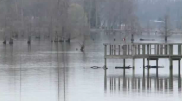Fukushima: A Year Later
A year on from the Fukushima disaster, Japan is still struggling to recover. From cleaning up areas still contaminated with radioactivity to rebuilding trust in its people, Japan has seen improvement, but there is still much to be done.
The details of the damage are still largely unknown, especially when it comes to radiation and debris. Even so, one certainty is clear -- life as they knew it has not yet returned.
Radiation concerns
NPR reports many formerly bustling areas adjacent to the Fukushima region are still recovering.
Young adults and families with children are hesitant to come back to these areas for fear of radioactivity, even in areas the government has declared as safe.
Minoru Nemoto, a decontamination worker in Nihonmatsu City, told NPR the recovery process is inefficient and leaves many unsure whether or not to return to their homes.
"Radiation is the biggest issue to be solved, otherwise people won't feel safe or comfortable living in Fukushima again," he says. "People have doubts about everything, and they're skeptical about anything they hear."
Beyond its buildings, the radiation contamination of food grown in the region is still a major concern. Although food quality tests are still routinely done, some are unconvinced of the results.
Takashi Sato of the Fukushima Federation of Agricultural Cooperative Associations told the AFP the caps set by the Japanese government are too lenient.
"People don't believe in the government's screening system. We want the government to work to convince the public that the new cap is genuinely safe," he said.
Starting in April, officials say no food will be sold if it has more than 100 becquerels of radiation per kilogram. This is down from the current cap of 500 becquerels, but many say it should have an even stricter cap.
This distrust goes beyond radiation caps. Many Japanese are unsatisfied with their government's overall management of the disaster.
In documents revealed by the Associated Press on Mar. 9, government crisis management meetings were plagued by miscommunication, confusion and lack of available, accurate reports. This lead to deep frustration among those dealing with the disaster -- a frustration which continues today.
Sheila Smith, senior fellow for Japan studies at the Council on Foreign Relations in Washington, D.C., told the National Geographic how low national trust discourages private investors from participating in the massive rebuilding of Japan.
"The big picture is the shattering of public confidence, not just in the nuclear program, but also in the government itself," she said.
The New York Times reports the last two remaining nuclear generators operating in Japan will be shut down by the end of this month. Prime Minister Naoto Kan also has announced a goal of 10 million solar-powered homes by 2020.
Even so, it's far from a clean energy victory. The country is still dependant on fossil fuels in the short term. Moreover, due to Japan's lack of fossil fuel resources, the country is relying more than ever on costly imports.
Drifting debris
The damage may very well continue beyond Japan. Reports say debris from the disaster is adrift in the Pacific Ocean and heading toward the U.S. coast.
Of the two million tons of it that remains in the sea, 1 to 5 percent of it may reach Alaska, Hawaii, Oregon, Washington state, and Canada's British Columbia in the next two years.
Kathryn Higley of the Department of Nuclear Engineering and Radiation Health Physics at Oregon State University released a statement warning any to steer clear of whatever it may be.
"People should treat these debris with common sense; there could be some things mixed in there that are dangerous," she said. "But it will have nothing to do with radioactive contamination."
A method to remove radioactivity that is still being used in Fukushima is to hose down the contaminated area with high-pressure streams of water. Officials say trash that has been pounded by ocean waves for multiple months have little risk of carrying dangerous levels of radioactivity.
Radioactive or not, some of the trash is sure to be spread around. Nikolai Maximenko, a University of Hawaii researcher, explained to the Associated Press that even if the trash is spread out, it'll eventually be collected by currents.
"In many cases it's not density that matters, it's total amount," he said. "For example, if there's a current flowing around Midway island, that island would collect debris like a trawl moving across the ocean. It will collect all the debris on its way."
It is likely, he said, that some of wreckage will join the Great Pacific Garbage Patch -- a giant island of trash between Hawaii and California trapped by the ocean's currents.





